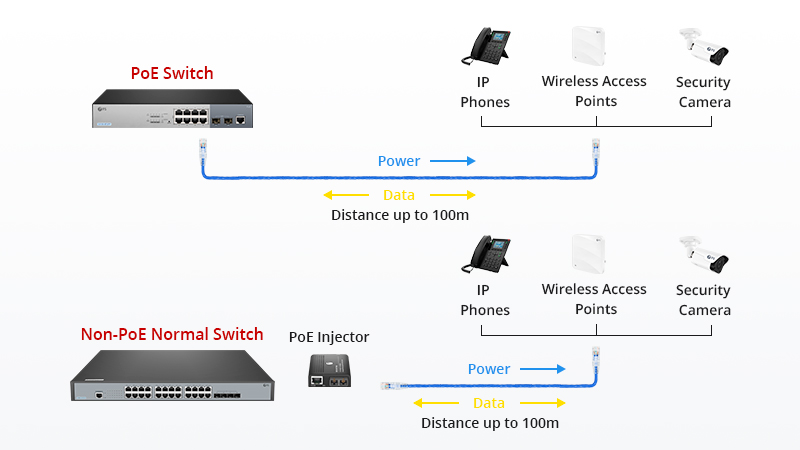The telecommunication industry has always been developing with leaps and bounds and technology changes with each passing day. For people with little network knowledge, the evolving optional network devices like PoE switches can be a big puzzle. What is PoE? What is the difference between a PoE switch and a regular network switch? This article explains their differences and how to find the right switch for you.
What is PoE?
PoE, short for Power over Ethernet, is a technology that enables Ethernet cable to supply power. Thus power sourcing equipment (PSE) can transmit both data and power to powered devices (PD) simultaneously via one single cable. PoE has two standards available on network switches: IEEE 802.3af/at. The former original PoE standard, defined in 2003, provides a 15.4 W power budget to PDs (12.95 W available for accessing). The latter PoE+/PoE Plus standard defined in 2009 provides up to 30 W (25.5 W) power.
What is a PoE Switch?
PoE switch is one of the two types of PSE for PoE implementation: endspan switch and midspan PoE injector. To enhance network resiliency, gigabit PoE switches provided by FS.COM are highly compatible with IEEE 802.3af/at managed PoE+ switches.
Also cheque – Unlocking the Secrets of PoE Switches – A Complete Guide
For example, FS S3150-8T2FP, an 8-Port Managed PoE+ switch, is equipped with 8x 10/100/1000BASE-T ports, 2x 1Gb SFP uplinks, 8x RJ45 ports support both IEEE 802.3af PoE and IEEE 802.3at PoE+ (up to 30W per port) for powering attached IP phones, wireless access points, or other standards-compliant PoE and PoE+ end network devices. 2x SFP uplink ports are provided to support connections to higher-layer devices.
Also cheque -FS PoE Switches

PoE Switch vs. Normal Switch: What’s the Difference?
In a word, the major difference between a PoE switch and a normal switch is PoE accessibility. A regular Ethernet switch is not PoE-enabled to supply power for end users over Ethernet. Therefore the user needs one extra cable to connect power outlets.
Also cheque – PoE Switch vs PoE Injector: Why Choose PoE Switch to Build Wireless Networks?
However, a normal switch can also become PoE-ready by employing a midspan injector between the switch and PDs. The injector will add electrical power while receiving the data signal from the Ethernet switch end cable, and then deliver both data and power to PDs. But in this circumstance, the injector also needs a wire for power.
When using a Gigabit PoE switch, only one power cable is required. Then the PDs can be directly plugged into the PoE gigabit switch port for both data transmission and power supply. The illustration and table below list the differences between deploying a PoE switch and a normal switch while adding PoE to networks.

| PoE Switch | Normal Switch | |
| Required Accessories | Easy for management (power and transmission) | Require separate two wires for powering on the normal switch and PoE injector |
| PoE Access Method | Upgrade to PoE network by replacing the normal Ethernet switch with PoE Ethernet switch | Install PoE injector between switch and PDs to add PoE capability to the existing non-PoE switch |
| Emergency Reaction | Potential chance of the whole system’s outage | Only one device be affected |
Advantages of PoE Switches
As mentioned above, the PoE switch supplies power to PDs in the meantime of data delivery. Though the normal switch system can also acquire PoE by installing an injector, PoE endspan has the superiority of direct Power over Ethernet ability. Thus, the Gigabit PoE switch owns edges over the normal switch.
First, it enables PDs like IP surveillance cameras to be placed almost anywhere: on the ceiling, concealed in a wall, or even underwater while only one cable is needed to run to them. Second, it saves extra expenses and time for power cabling and injector installation. Third, with simplified cabling of all PDs directly connected to gigabit PoE switch, the data centre is easy to manage and control.
Besides, the PoE gigabit switch itself is designed with advanced features like high-performance hardware with software, auto-sensing PoE compatibility, strong network security, and environmental adaptability.
Find the Right Switch For You
Gigabit PoE switches can supply power to PDs in the meantime of data transmission via one single Ethernet cable while normal switches can only send data to them. For PoE implementation, normal switches need a power-on auxiliary injector as a midspan between a switch and powered devices.
Thus, PoE switches have the advantage of direct PoE connection, easy and flexible placement, cost-efficiency, simplified management, etc. For any applications of IP surveillance cameras, IP phones, and wireless APs, a PoE switch can be the right choice you’re looking for.
